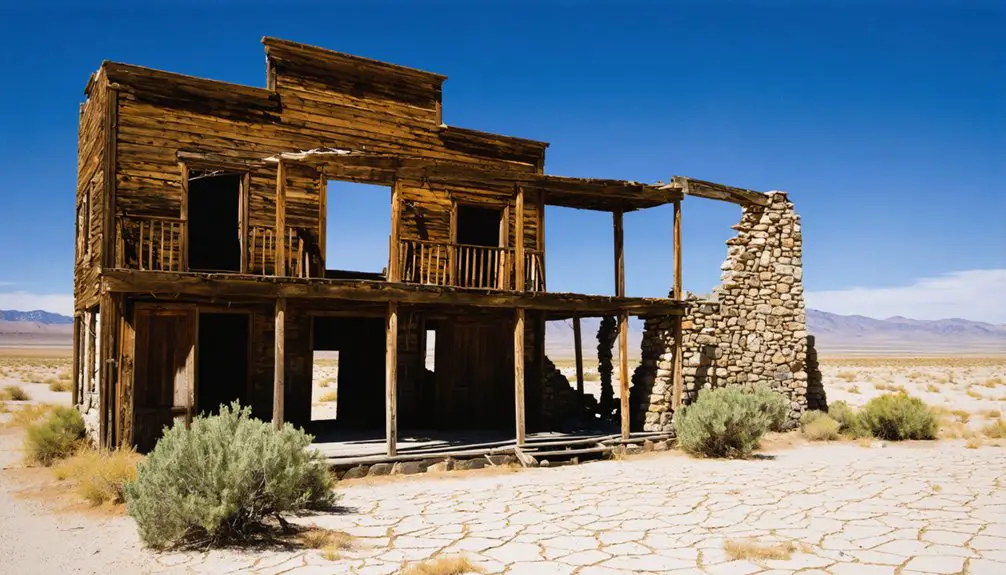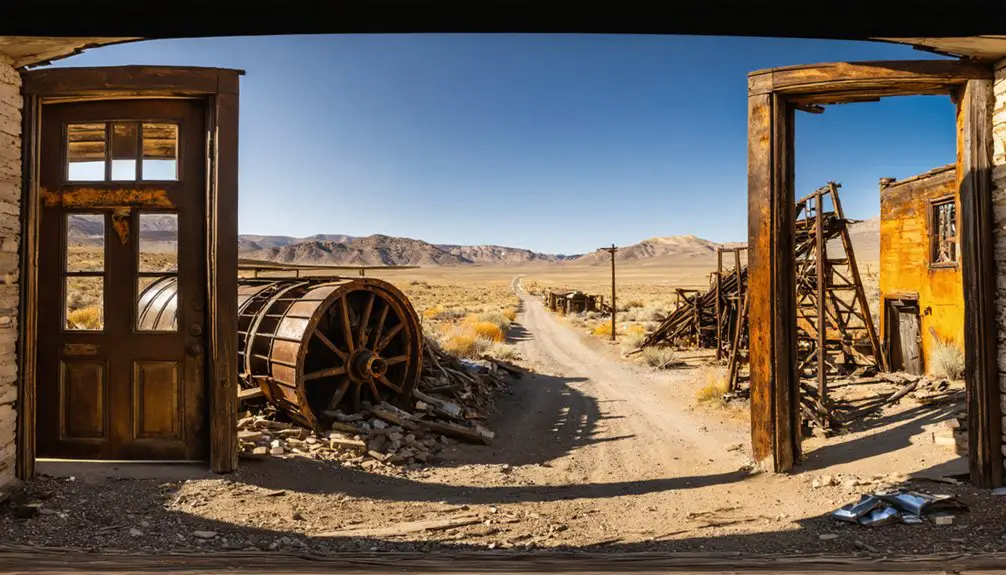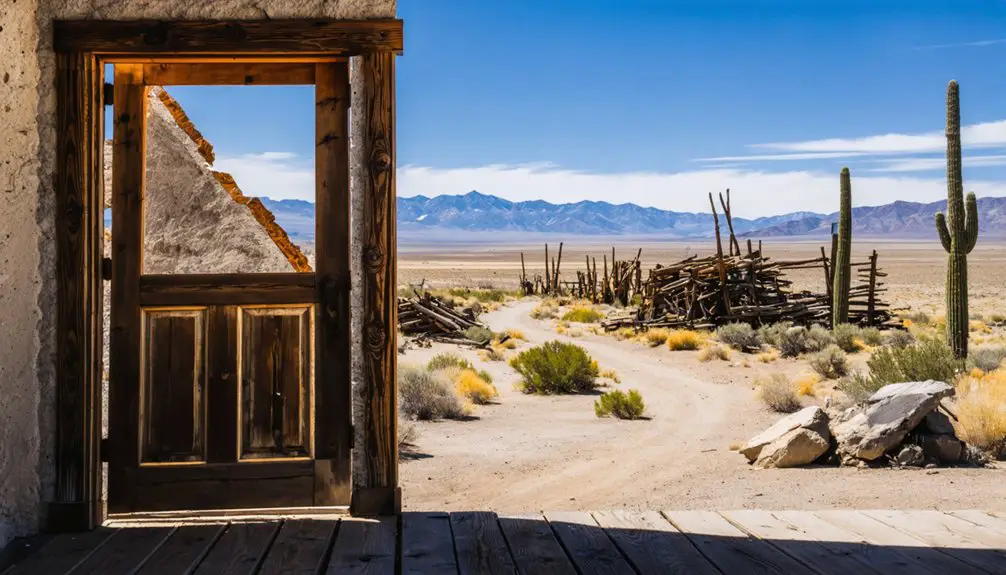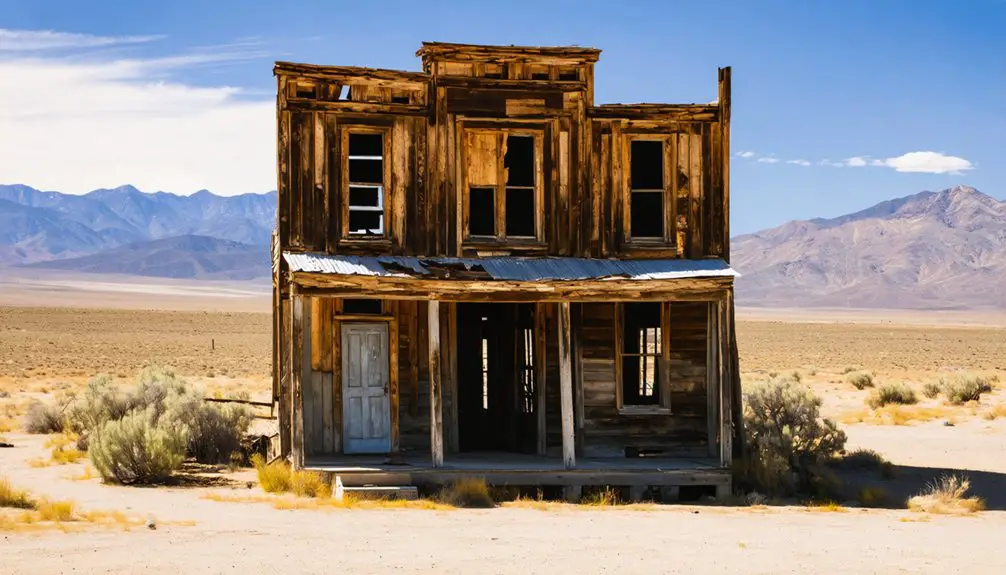You’ll find Seven Troughs nestled in a remote Nevada canyon where Joe Therien’s 1905 gold discovery sparked a mining boom that drew 5,000 people. The town, named after Frank Ward’s water troughs, flourished from 1907-1912, producing $2 million in gold before water flooding crippled operations. Today, you can explore the ghost town’s remnants, including stone foundations and industrial ruins that survived a 1990s wildfire – each structure telling a deeper story of boom-and-bust America.
Key Takeaways
- Seven Troughs began as a gold mining town in 1905 after Joe Therien’s discovery, attracting 5,000 miners during its peak years.
- The town flourished from 1907-1912, producing $2 million in gold through two 10-stamp mills and a cyanide plant.
- Severe water problems in 1917 flooded mine workings at 1,600 feet, contributing to the town’s eventual decline.
- A devastating 1912 flash flood and 1990s wildfire damaged the town, leaving only stone foundations and industrial ruins.
- Tunnel Camp, established in 1926, remains well-preserved with brick mill offices, wooden cabins, and mining equipment remnants.
The Discovery of Gold and Town Origins
After local blacksmith Joe Therien discovered gold and silver ore in Seven Troughs Canyon in 1905, the area quickly transformed from a humble sheep-grazing territory into a bustling mining district.
A chance discovery by a local craftsman turned quiet pastureland into a thriving center of mineral wealth.
The initial discoveries sparked an influx of about 5,000 miners and entrepreneurs who recognized the area’s potential, leading to multiple claims throughout the canyon. Many miners and business owners were transported to the area via automobile stage lines that carried 800 people daily.
You’ll find the district’s mining legacy began where Frank M. Ward had placed seven water troughs for his sheep in 1894, giving the area its distinctive name.
By mid-1907, the town was officially platted and a post office established, marking Seven Troughs’ evolution from a simple shepherding stop to a proper settlement.
The district’s rich deposits attracted companies like Seven Troughs Therian Gold Mines Company, setting the stage for decades of prosperous mining operations that would yield 158,468 ounces of gold between 1907 and 1955.
Life in the Early Mining Community
You’d find Seven Troughs’ daily routines centered around eight-hour mine shifts, with workers heading to and from the mines while merchants and families kept the town’s services running.
The community’s social life revolved around gathering spots like hotels, stores, and particularly the saloons, which weren’t typical rowdy mining town establishments but rather served as evening meeting places for catching up on news and socializing. The town’s plots were in high demand, with each parcel selling for plots sold for $500.
Unlike many boom towns of the era, Seven Troughs maintained a surprisingly sober atmosphere during working hours, reflecting the community’s focus on sustainable mining operations rather than temporary entertainment. The area’s history began when Joe Therien discovered valuable gold and silver deposits in 1905.
Daily Community Routines
Life in Seven Troughs revolved around the demanding rhythms of mining operations, with workers rotating through round-the-clock shifts to maximize ore extraction.
You’d find miners and mill workers engaged in continuous ore processing while battling persistent water intrusion issues that frequently disrupted their routines.
Community engagement centered around essential services like the post office, mercantile shops, schools, and saloons.
You’d have witnessed the daily challenges of water management, vital for both mining operations and household needs.
The town’s residents adapted to these routine challenges, creating a resilient community of several hundred people by 1907.
Basic infrastructure included wooden houses and cabins, many of which still stand today near Tunnel Camp, proof of the hardy living conditions of mining life.
The town experienced tragedy when a flash flood in 1912 claimed eight lives and destroyed numerous buildings.
A devastating wildfire in the early 1990s destroyed many of the remaining wooden structures throughout the mining district.
Social Gathering Places
The social fabric of Seven Troughs took shape around key gathering spots that defined the mining community’s daily interactions. You’d find multiple saloons operating by 1907, serving not just as drinking establishments but as centers of social cohesion where miners gathered for evening storytelling and informal meetings.
The town’s hotel hosted communal events while general stores became essential hubs where you could trade goods and catch up on local news.
The post office, established in 1907, connected you to the outside world, while the school built in 1908 brought families together.
Unlike rowdier mining camps, Seven Troughs maintained a more moderate atmosphere in its social venues, where you’d find residents focused more on building community bonds than heavy drinking.
Peak Mining Operations and Economic Growth
During Seven Troughs’ most prosperous years between 1907-1912, mining operations expanded rapidly as two 10-stamp mills processed rich gold ore yielding $600 per ton. The economic impact was substantial, with some ore values reaching an astounding $100,000 per ton.
Mining technology advanced when the Seven Troughs Coalition Mining Company added a cyanide plant in 1911, enhancing gold and silver extraction efficiency. In 1927, the Nevada State Mining Co. established Tunnel Camp to expand mining operations through an ambitious tunnel project.
The addition of cyanide processing in 1911 marked a significant technological leap forward for Seven Troughs’ mining operations.
The district’s prosperity supported a stable community of 350 residents in Seven Troughs proper, while generating roughly two million dollars in gold production between 1908 and 1918. A devastating flash flood in 1912 destroyed most of the town’s structures.
Workers earned $5 per day on eight-hour shifts, reflecting strong labor conditions. Though the district never secured its planned railroad connections, it maintained a thriving economy with hotels, stores, schools, and other essential services.
The Role of Water in Seven Troughs’ History
Water played a pivotal role in Seven Troughs’ development, beginning with Frank M. Ward’s construction of seven sheep-watering troughs in 1894. The area’s water management later shifted from ranching to mining dependency when gold and silver were discovered in 1905.
You’ll find water’s importance reflected in the placement of essential facilities like the Kindergarten Mill and Coalition Cyanide Plant.
However, water proved both beneficial and destructive. The devastating flood of 1912 ravaged the mining infrastructure, particularly in nearby Mazuma. A 20-foot wave crashed through Mazuma, destroying the post office and other buildings. Recovery workers from Lovelock arrived with doctors, nurses, and aid supplies.
Later, in 1917, water infiltration through cross-fissures flooded the Coalition Mine’s underground workings, spreading to connected mines. These water-related disasters effectively ended Seven Troughs’ mining boom, as drainage attempts failed and operations couldn’t recover.
The once-thriving district’s dependence on water ultimately contributed to its downfall.
Buildings and Infrastructure Development

Following the 1905 discovery of high-grade gold ore, Seven Troughs rapidly developed into a bustling mining community with extensive infrastructure. Building materials came from local sources, reflecting typical early 20th-century mining town architectural styles.
You’ll find the most well-preserved structures at Tunnel Camp, established in 1926-1927, where many buildings were relocated from the abandoned Vernon townsite.
Key infrastructure developments included:
- Two 10-stamp mills by 1908 for processing $600/ton gold ore
- A massive 100-ton Friedman ball mill and cyanide plant completed in 1930
- A diesel power plant featuring three 120-hp Fairbanks-Morse engines housed in galvanized steel
While most wooden structures in Seven Troughs Canyon succumbed to a 1990s wildfire, you can still explore remaining stone foundations, ore hoppers, and industrial ruins today.
Mining Challenges and Production Decline
Although Seven Troughs initially showed great promise as a gold mining district, severe water problems beginning in 1917 marked the start of its decline. You’ll find that flooding at the 1600-foot level inundated three miles of workings, while persistent water seepage through cross-fissures plagued the Coalition, Seven Troughs, and Mazuma Hills mines.
The ambitious Deep Tunnel project, meant to solve these mining failures, proved disastrous. Engineering miscalculations and uncontrollable water intrusion halted the 2.5-mile drainage tunnel by 1937.
These setbacks, combined with depleting gold veins, triggered major economic downturns. Despite $3 million invested in infrastructure, the district’s total production reached only $2 million before large-scale operations ceased.
The Rise and Fall of Tunnel Camp

You’ll find Tunnel Camp’s ambitious revival plans centered on its massive tunnel project, which aimed to drain flooded mine shafts and improve ore transport across 2.5 miles of mountain terrain.
The daily grind of underground work involved miners operating in challenging conditions while massive Fairbanks-Morse diesel engines powered the camp’s essential operations above ground.
Despite significant infrastructure investment, including a new cyanide plant and 100-ton Friedman ball mill, the camp’s development faced ongoing technical difficulties that ultimately contributed to its decline by the early 1930s.
Mining Revival Plans
While many ghost towns faded gradually, Tunnel Camp emerged in 1926 as an ambitious attempt to revive Seven Troughs’ mining fortunes through a massive drainage project. The camp embodied mining innovation and economic optimism, with entrepreneur Louis A. Friedman spearheading a bold $3 million investment in infrastructure.
The revival plan centered on three major developments:
- A deep drainage tunnel extending over 10,000 feet to access flooded mine shafts
- A modern power plant featuring three 120 h.p. Fairbanks-Morse diesel engines
- A large-scale 100-ton Friedman ball mill and cyanide processing facility
Despite these impressive investments, the project ultimately failed due to engineering miscalculations. The tunnel’s incorrect angle prevented it from reaching its target shafts, and by 1934, following Friedman’s death, the once-promising revival came to an end.
Daily Life Underground
Life at Tunnel Camp in the late 1920s centered around an ambitious underground project that shaped both industrial operations and community dynamics.
You’d find workers tackling the demanding tunnel excavation using manual underground tools, pushing deeper into the earth day after day. By 1928, they’d reached 5,495 feet, extending to 7,200 feet by early 1929.
Your daily routine would’ve revolved around the company-provided amenities – sleeping in the bunkhouse, cleaning up in the bathhouse, and gathering supplies at the company store.
While mine safety standards were basic by today’s measures, the camp offered decent living conditions with housing and basic services.
The three Fairbanks-Morse diesel engines at the power plant kept operations humming, while the cyanide and ball mills processed the extracted ore.
Infrastructure Development Battle
In late 1926, the Nevada State Mining Company established Tunnel Camp with an ambitious vision to revolutionize mining operations through advanced infrastructure development.
You’ll find that their tunnel engineering project aimed to replicate the success of Virginia City’s Sutro Tunnel, focusing on water drainage and ore transport efficiency.
The mining infrastructure battle involved three major developments:
- Construction of a 2.5-mile horizontal tunnel reaching 7,200 feet by 1929
- Installation of a powerhouse with three 120-horsepower Fairbanks-Morse diesel engines
- Development of a 100-ton Friedman ball mill and cyanide plant by 1930
Despite these impressive advancements, you’ll discover that persistent water intrusion ultimately defeated the project.
What Remains Today: A Ghost Town Legacy

Today’s visitors to Seven Troughs will find a ghost town landscape dominated by the well-preserved structures of Tunnel Camp rather than the original mining settlement.
While the original 1905 boomtown has largely vanished, Tunnel Camp’s 1927 structures showcase remarkable ghost town preservation, including an impressive red brick mill office, intact wooden cabins, and a prominent stamp mill with its loading chute.
You’ll discover that fire and harsh desert conditions have claimed most wooden structures from the earlier mining era, though Tunnel Camp’s relatively young age and continued habitation until 2000 helped protect its buildings.
The historical significance of this district lives on through scattered mine tailings, two weathered graveyards, and the remnants of what was once a thriving gold mining community that produced ore worth $600 per ton.
Frequently Asked Questions
Were There Any Notable Crimes or Lawlessness Incidents in Seven Troughs?
You won’t find significant crime rates or lawlessness documented in records, as the town maintained unusual order for a mining camp despite minimal law enforcement presence – apart from Dixon’s unsolved 1978 disappearance.
What Happened to the Mining Equipment After the Town Was Abandoned?
You’ll find most mining equipment was simply abandoned in place after flooding, with no major disposal or salvage efforts. Today, these rusted remains serve as historical artifacts for preservation and tourism.
Did Any Famous People Ever Visit or Invest in Seven Troughs?
Like a miner’s empty gold pan, records show no famous visitors ventured to this remote camp. You won’t find any celebrity investors or well-known magnates in the town’s historical documents.
How Did Children Receive Education Beyond the Elementary School Level?
You’d have to leave town for higher education, either attending boarding schools or traveling to larger communities. Local teachers couldn’t provide advanced instruction beyond elementary education methods in this remote setting.
Were There Any Significant Native American Interactions With the Mining Community?
Silent as the desert wind, you won’t find documented evidence of cultural exchange or trade relations between Native Americans and Seven Troughs miners, though Northern Paiute tribes traditionally inhabited the region.
References
- https://en.wikipedia.org/wiki/Seven_Troughs
- https://travelnevada.com/ghost-town/seven-troughs-ghost-town/
- https://www.destination4x4.com/seven-troughs-nevada-pershing-county/
- https://www.nevadaappeal.com/news/2019/sep/04/tunnel-camp-boasts-short-life-but-long-history/
- https://www.nvexpeditions.com/pershing/seventroughs.php
- https://www.hmdb.org/m.asp?m=167134
- https://westernmininghistory.com/towns/nevada/seven-troughs/
- https://www.atlasobscura.com/places/tunnel-camp-and-the-seven-troughs-district
- https://www.wayalife.com/threads/seven-troughs-nevada-exploration.9676/
- https://nvtami.com/2021/12/30/tunnel-camp-nevada-ghost-town/



